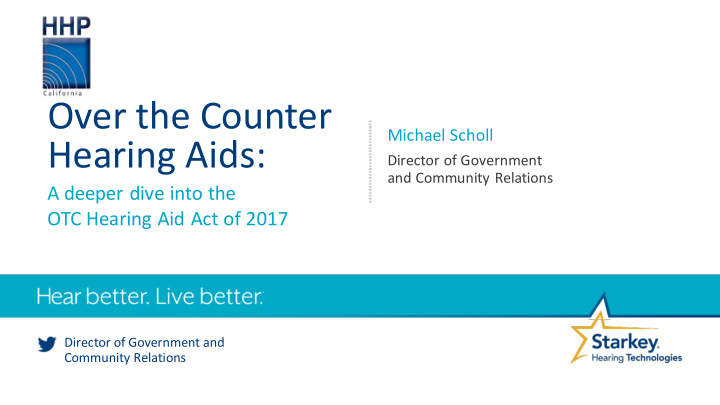



Over the Counter Michael Scholl Hearing Aids: Director of Government and Community Relations A deeper dive into the OTC Hearing Aid Act of 2017 Director of Government and Community Relations
OTC Legislation 2009 – NIH Workgroup to identify research needs for increased accessibility and affordability. 2015 – PCAST Study 2016 – NASEM meeting to discuss strategies to address accessibility and affordability.
OTC Legislation July 12, Aug. 18, 2017 Aug. 3, 2017 2017 Passed the House Passed the Senate Signed into law by of the president Representatives
Definition of OTC Hearing aid “Over -the- counter hearing aid” - a device that: • Uses same technology as air conduction or wireless air conduction hearing aids; • Is intended to be used by adults over the age of 18 to compensate for perceived mild to moderate hearing impairment; • Through tools, tests, or software, allows the user to control the over-the-counter hearing aid and customize it to the user’s hearing needs; • May use wireless technology; • May include tests for self-assessment of hearing loss; and • Is available over-the-counter, without the supervision, prescription, or other order, involvement, or intervention of a licensed person to consumer through in-person transactions by mail or online.
Concessions from congress • Stronger labeling requirements to include information on how consumers may report adverse events, or symptoms of medically treatable causes of hearing loss • Requirements that the FDA should consult with relevant stakeholders, including hearing aid manufacturers, licensed hearing professionals, patients, and others, during the rulemaking process • No later than two years after the FDA regulations are finalized, a report issued by the Secretary of Health and Human Services analyzing the impact of over-the-counter hearing aids
Regulations of OTC Hearing Aids • 3 years to promulgate proposed regulations • Public comment period (generally 60 days) • 180 days after public comment period, issue final regulations • April 19, 2021
Regulations by the FDA
Safety and Requirements Efficacy for Sale Output Limits Labeling
Safety and Requirements Efficacy for Sale Include requirements that provide reasonable assurances of the safety and efficacy of over- the-counter hearing aids Output Limits Labeling
Safety and Requirements Efficacy for Sale Output Limits Labeling
Safety and Requirements Efficacy for Sale Include requirements that establish or adopt output limits appropriate for over-the-counter hearing aids Output Limits Labeling
Safety and Requirements Efficacy for Sale Output Limits Labeling
Safety and Requirements Efficacy for Sale Include requirements for appropriate labeling of the over-the-counter hearing aid, including how consumers may report adverse events, any conditions or contraindications, and any advisements to consult promptly with a licensed physician Output Limits Labeling
Safety and Requirements Efficacy for Sale Output Limits Labeling
Safety and Requirements Efficacy for Sale Describe the requirements under which sale of over-the-counter hearing aids is permitted, without the supervision, prescription, or other order, involvement, or intervention of a licensed person, to consumers through in-person transactions, by mail, or online Output Limits Labeling
Other TBD by fda • Premarket notification - Will the FDA make OTC devices 510(k) exempt? • PSAP Guidance - FDA to update and finalize 2013 draft guidance titled, “Regulatory Requirements for Hearing Aid Devices and Personal Sound Amplification Products.”
Center for devices and radiological health
The decision makers at the FDA Jeffery Shuren, Director for Devices and Radiological Health (CDRH) Dr. Srinivas “ Nandu ” Nandkumar, Branch Chief for ENT - How to stay in touch with FDA: - https://www.fda.gov/RegulatoryInformation/Dockets/Comments/default.htm
Recommend
More recommend